Management Accounting Report: Coffee Pound Business Analysis
VerifiedAdded on 2020/07/23
|19
|5534
|43
Report
AI Summary
This comprehensive management accounting report analyzes the financial performance of Coffee Pound, a small business in the restaurant industry. The report covers various aspects of management accounting, including its types, roles, and techniques. It explores inventory management, cost accounting, and price-optimizing systems. The report includes a detailed comparison between management and financial accounting. Furthermore, it presents income statements using both marginal and absorption costing methods, along with an explanation of the differences between the two. It also discusses various budgeting and pricing methods suitable for Coffee Pound, along with the application and advantages of a management accounting system. The report also evaluates the integration of the management accounting system within the organization, focusing on setting prices, providing cost centers, facilitating decision-making, and preparing budgets. Finally, the report outlines how the management accounting system can address financial problems, and discusses the benefits of planning tools for a sustainable organization.
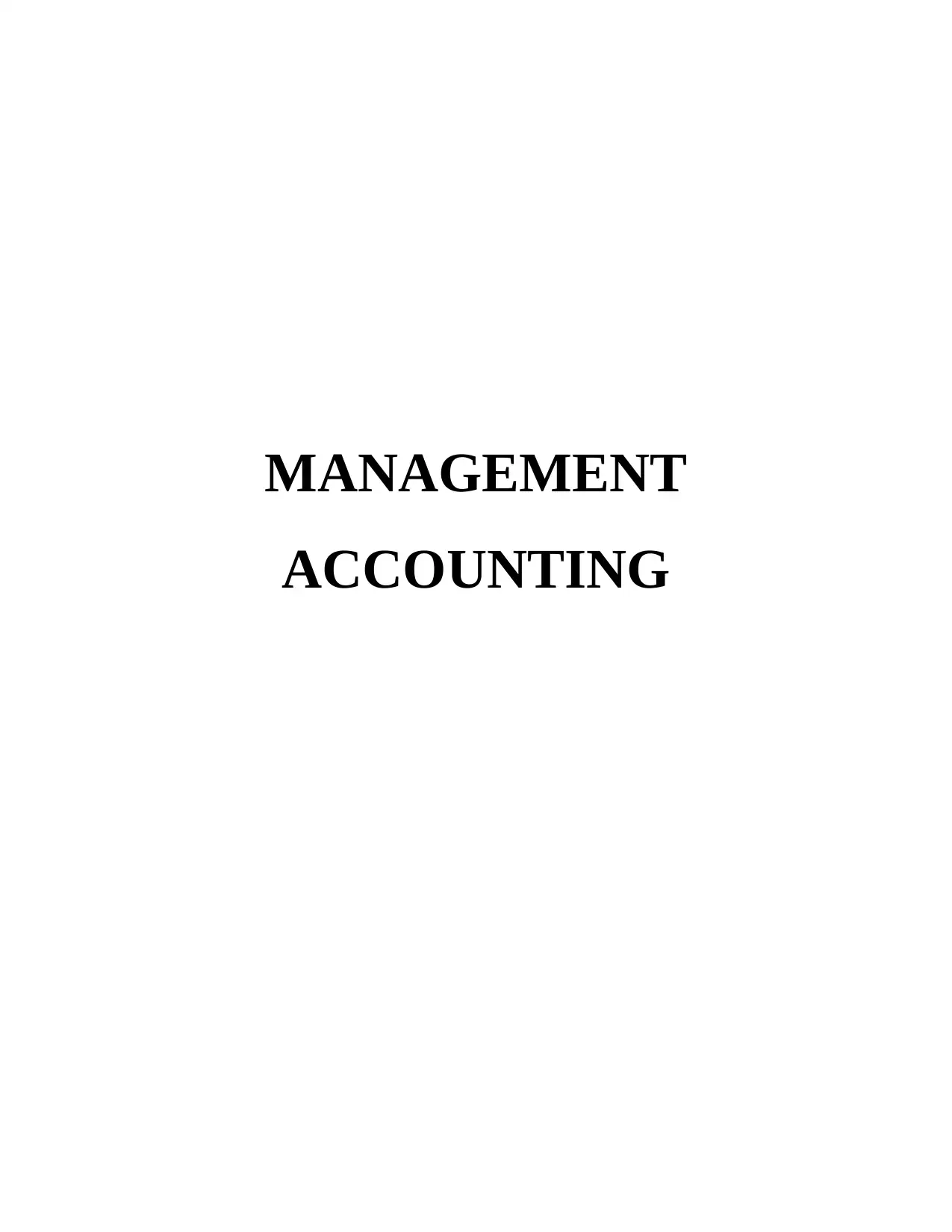
MANAGEMENT
ACCOUNTING
ACCOUNTING
Paraphrase This Document
Need a fresh take? Get an instant paraphrase of this document with our AI Paraphraser
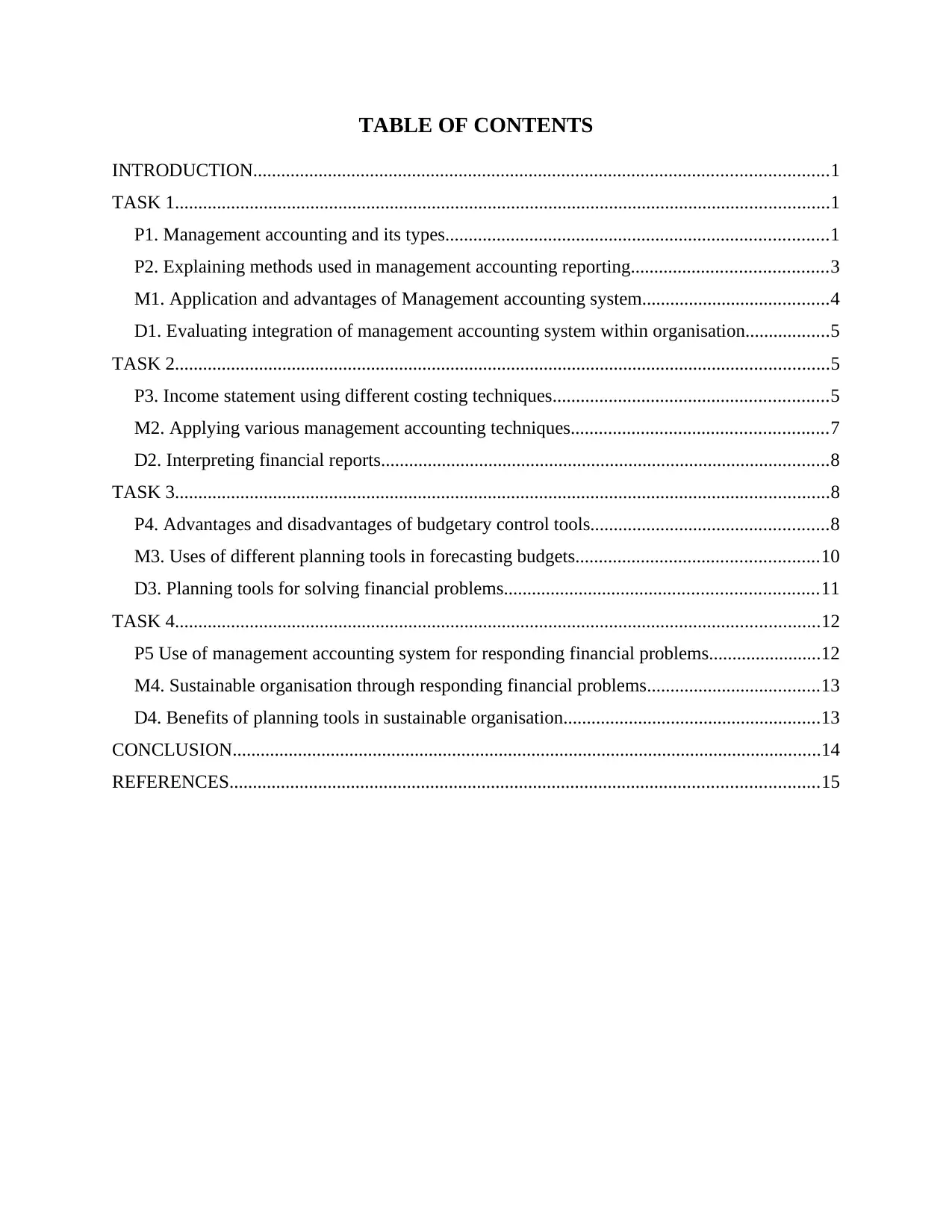
TABLE OF CONTENTS
INTRODUCTION...........................................................................................................................1
TASK 1............................................................................................................................................1
P1. Management accounting and its types..................................................................................1
P2. Explaining methods used in management accounting reporting..........................................3
M1. Application and advantages of Management accounting system........................................4
D1. Evaluating integration of management accounting system within organisation..................5
TASK 2............................................................................................................................................5
P3. Income statement using different costing techniques...........................................................5
M2. Applying various management accounting techniques.......................................................7
D2. Interpreting financial reports................................................................................................8
TASK 3............................................................................................................................................8
P4. Advantages and disadvantages of budgetary control tools...................................................8
M3. Uses of different planning tools in forecasting budgets....................................................10
D3. Planning tools for solving financial problems...................................................................11
TASK 4..........................................................................................................................................12
P5 Use of management accounting system for responding financial problems........................12
M4. Sustainable organisation through responding financial problems.....................................13
D4. Benefits of planning tools in sustainable organisation.......................................................13
CONCLUSION..............................................................................................................................14
REFERENCES..............................................................................................................................15
INTRODUCTION...........................................................................................................................1
TASK 1............................................................................................................................................1
P1. Management accounting and its types..................................................................................1
P2. Explaining methods used in management accounting reporting..........................................3
M1. Application and advantages of Management accounting system........................................4
D1. Evaluating integration of management accounting system within organisation..................5
TASK 2............................................................................................................................................5
P3. Income statement using different costing techniques...........................................................5
M2. Applying various management accounting techniques.......................................................7
D2. Interpreting financial reports................................................................................................8
TASK 3............................................................................................................................................8
P4. Advantages and disadvantages of budgetary control tools...................................................8
M3. Uses of different planning tools in forecasting budgets....................................................10
D3. Planning tools for solving financial problems...................................................................11
TASK 4..........................................................................................................................................12
P5 Use of management accounting system for responding financial problems........................12
M4. Sustainable organisation through responding financial problems.....................................13
D4. Benefits of planning tools in sustainable organisation.......................................................13
CONCLUSION..............................................................................................................................14
REFERENCES..............................................................................................................................15
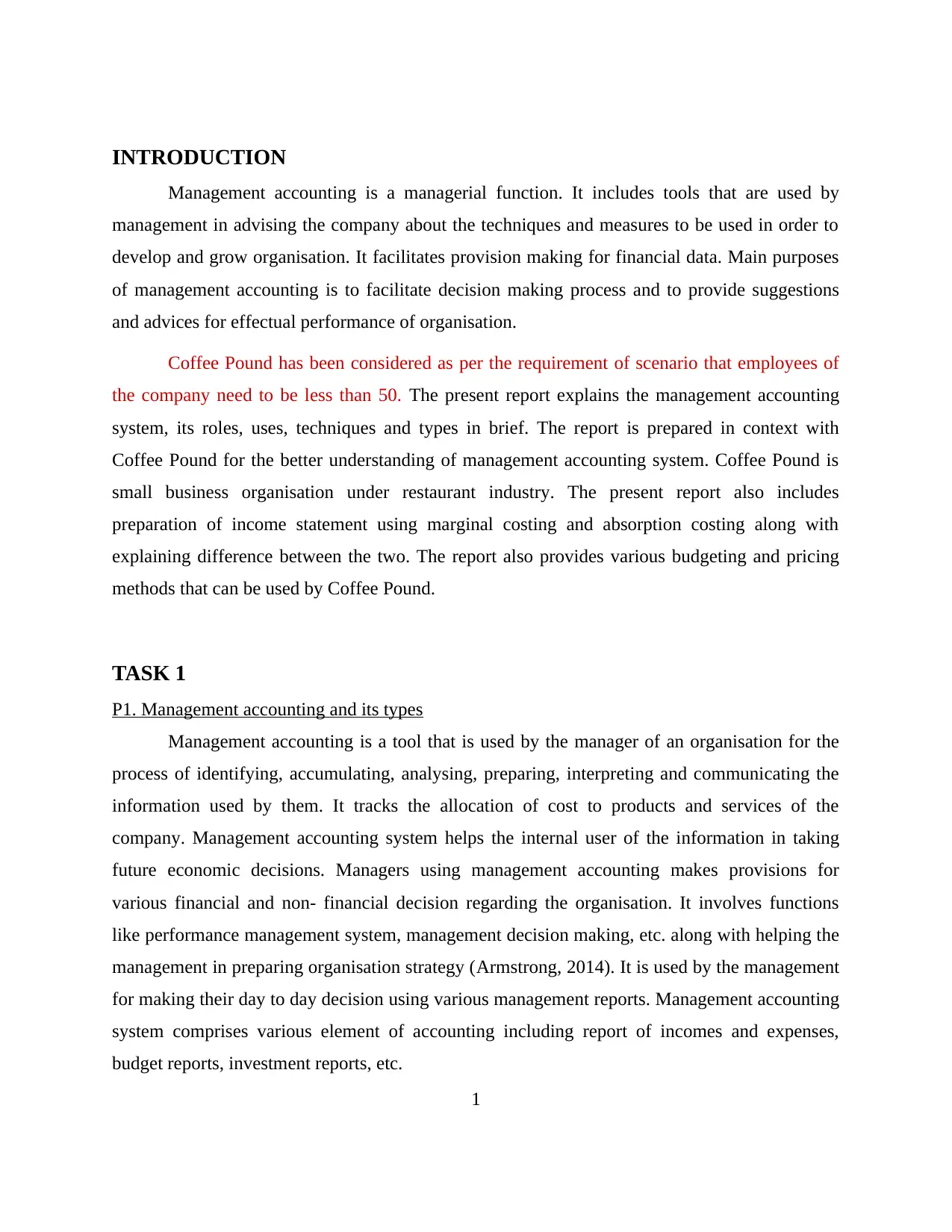
INTRODUCTION
Management accounting is a managerial function. It includes tools that are used by
management in advising the company about the techniques and measures to be used in order to
develop and grow organisation. It facilitates provision making for financial data. Main purposes
of management accounting is to facilitate decision making process and to provide suggestions
and advices for effectual performance of organisation.
Coffee Pound has been considered as per the requirement of scenario that employees of
the company need to be less than 50. The present report explains the management accounting
system, its roles, uses, techniques and types in brief. The report is prepared in context with
Coffee Pound for the better understanding of management accounting system. Coffee Pound is
small business organisation under restaurant industry. The present report also includes
preparation of income statement using marginal costing and absorption costing along with
explaining difference between the two. The report also provides various budgeting and pricing
methods that can be used by Coffee Pound.
TASK 1
P1. Management accounting and its types
Management accounting is a tool that is used by the manager of an organisation for the
process of identifying, accumulating, analysing, preparing, interpreting and communicating the
information used by them. It tracks the allocation of cost to products and services of the
company. Management accounting system helps the internal user of the information in taking
future economic decisions. Managers using management accounting makes provisions for
various financial and non- financial decision regarding the organisation. It involves functions
like performance management system, management decision making, etc. along with helping the
management in preparing organisation strategy (Armstrong, 2014). It is used by the management
for making their day to day decision using various management reports. Management accounting
system comprises various element of accounting including report of incomes and expenses,
budget reports, investment reports, etc.
1
Management accounting is a managerial function. It includes tools that are used by
management in advising the company about the techniques and measures to be used in order to
develop and grow organisation. It facilitates provision making for financial data. Main purposes
of management accounting is to facilitate decision making process and to provide suggestions
and advices for effectual performance of organisation.
Coffee Pound has been considered as per the requirement of scenario that employees of
the company need to be less than 50. The present report explains the management accounting
system, its roles, uses, techniques and types in brief. The report is prepared in context with
Coffee Pound for the better understanding of management accounting system. Coffee Pound is
small business organisation under restaurant industry. The present report also includes
preparation of income statement using marginal costing and absorption costing along with
explaining difference between the two. The report also provides various budgeting and pricing
methods that can be used by Coffee Pound.
TASK 1
P1. Management accounting and its types
Management accounting is a tool that is used by the manager of an organisation for the
process of identifying, accumulating, analysing, preparing, interpreting and communicating the
information used by them. It tracks the allocation of cost to products and services of the
company. Management accounting system helps the internal user of the information in taking
future economic decisions. Managers using management accounting makes provisions for
various financial and non- financial decision regarding the organisation. It involves functions
like performance management system, management decision making, etc. along with helping the
management in preparing organisation strategy (Armstrong, 2014). It is used by the management
for making their day to day decision using various management reports. Management accounting
system comprises various element of accounting including report of incomes and expenses,
budget reports, investment reports, etc.
1
⊘ This is a preview!⊘
Do you want full access?
Subscribe today to unlock all pages.

Trusted by 1+ million students worldwide
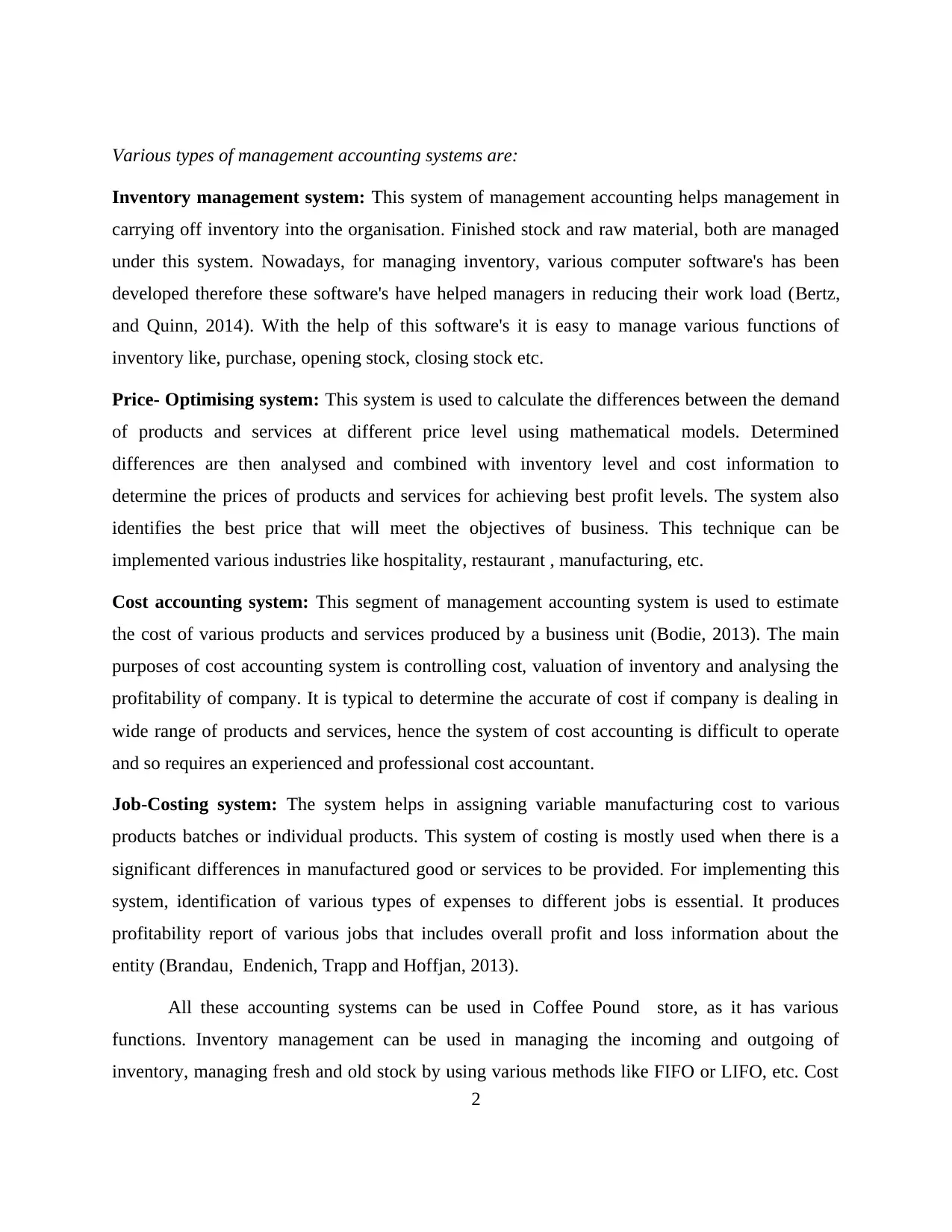
Various types of management accounting systems are:
Inventory management system: This system of management accounting helps management in
carrying off inventory into the organisation. Finished stock and raw material, both are managed
under this system. Nowadays, for managing inventory, various computer software's has been
developed therefore these software's have helped managers in reducing their work load (Bertz,
and Quinn, 2014). With the help of this software's it is easy to manage various functions of
inventory like, purchase, opening stock, closing stock etc.
Price- Optimising system: This system is used to calculate the differences between the demand
of products and services at different price level using mathematical models. Determined
differences are then analysed and combined with inventory level and cost information to
determine the prices of products and services for achieving best profit levels. The system also
identifies the best price that will meet the objectives of business. This technique can be
implemented various industries like hospitality, restaurant , manufacturing, etc.
Cost accounting system: This segment of management accounting system is used to estimate
the cost of various products and services produced by a business unit (Bodie, 2013). The main
purposes of cost accounting system is controlling cost, valuation of inventory and analysing the
profitability of company. It is typical to determine the accurate of cost if company is dealing in
wide range of products and services, hence the system of cost accounting is difficult to operate
and so requires an experienced and professional cost accountant.
Job-Costing system: The system helps in assigning variable manufacturing cost to various
products batches or individual products. This system of costing is mostly used when there is a
significant differences in manufactured good or services to be provided. For implementing this
system, identification of various types of expenses to different jobs is essential. It produces
profitability report of various jobs that includes overall profit and loss information about the
entity (Brandau, Endenich, Trapp and Hoffjan, 2013).
All these accounting systems can be used in Coffee Pound store, as it has various
functions. Inventory management can be used in managing the incoming and outgoing of
inventory, managing fresh and old stock by using various methods like FIFO or LIFO, etc. Cost
2
Inventory management system: This system of management accounting helps management in
carrying off inventory into the organisation. Finished stock and raw material, both are managed
under this system. Nowadays, for managing inventory, various computer software's has been
developed therefore these software's have helped managers in reducing their work load (Bertz,
and Quinn, 2014). With the help of this software's it is easy to manage various functions of
inventory like, purchase, opening stock, closing stock etc.
Price- Optimising system: This system is used to calculate the differences between the demand
of products and services at different price level using mathematical models. Determined
differences are then analysed and combined with inventory level and cost information to
determine the prices of products and services for achieving best profit levels. The system also
identifies the best price that will meet the objectives of business. This technique can be
implemented various industries like hospitality, restaurant , manufacturing, etc.
Cost accounting system: This segment of management accounting system is used to estimate
the cost of various products and services produced by a business unit (Bodie, 2013). The main
purposes of cost accounting system is controlling cost, valuation of inventory and analysing the
profitability of company. It is typical to determine the accurate of cost if company is dealing in
wide range of products and services, hence the system of cost accounting is difficult to operate
and so requires an experienced and professional cost accountant.
Job-Costing system: The system helps in assigning variable manufacturing cost to various
products batches or individual products. This system of costing is mostly used when there is a
significant differences in manufactured good or services to be provided. For implementing this
system, identification of various types of expenses to different jobs is essential. It produces
profitability report of various jobs that includes overall profit and loss information about the
entity (Brandau, Endenich, Trapp and Hoffjan, 2013).
All these accounting systems can be used in Coffee Pound store, as it has various
functions. Inventory management can be used in managing the incoming and outgoing of
inventory, managing fresh and old stock by using various methods like FIFO or LIFO, etc. Cost
2
Paraphrase This Document
Need a fresh take? Get an instant paraphrase of this document with our AI Paraphraser
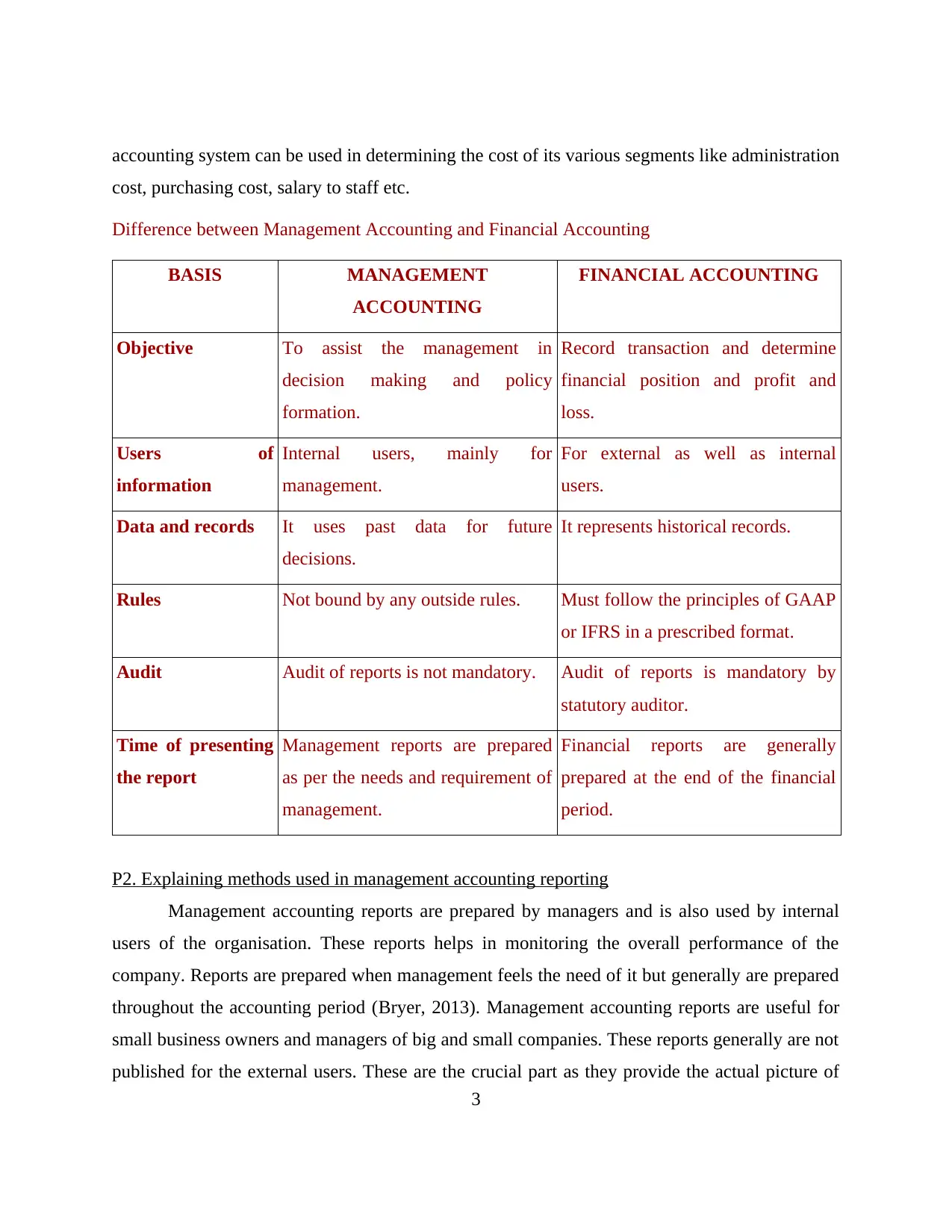
accounting system can be used in determining the cost of its various segments like administration
cost, purchasing cost, salary to staff etc.
Difference between Management Accounting and Financial Accounting
BASIS MANAGEMENT
ACCOUNTING
FINANCIAL ACCOUNTING
Objective To assist the management in
decision making and policy
formation.
Record transaction and determine
financial position and profit and
loss.
Users of
information
Internal users, mainly for
management.
For external as well as internal
users.
Data and records It uses past data for future
decisions.
It represents historical records.
Rules Not bound by any outside rules. Must follow the principles of GAAP
or IFRS in a prescribed format.
Audit Audit of reports is not mandatory. Audit of reports is mandatory by
statutory auditor.
Time of presenting
the report
Management reports are prepared
as per the needs and requirement of
management.
Financial reports are generally
prepared at the end of the financial
period.
P2. Explaining methods used in management accounting reporting
Management accounting reports are prepared by managers and is also used by internal
users of the organisation. These reports helps in monitoring the overall performance of the
company. Reports are prepared when management feels the need of it but generally are prepared
throughout the accounting period (Bryer, 2013). Management accounting reports are useful for
small business owners and managers of big and small companies. These reports generally are not
published for the external users. These are the crucial part as they provide the actual picture of
3
cost, purchasing cost, salary to staff etc.
Difference between Management Accounting and Financial Accounting
BASIS MANAGEMENT
ACCOUNTING
FINANCIAL ACCOUNTING
Objective To assist the management in
decision making and policy
formation.
Record transaction and determine
financial position and profit and
loss.
Users of
information
Internal users, mainly for
management.
For external as well as internal
users.
Data and records It uses past data for future
decisions.
It represents historical records.
Rules Not bound by any outside rules. Must follow the principles of GAAP
or IFRS in a prescribed format.
Audit Audit of reports is not mandatory. Audit of reports is mandatory by
statutory auditor.
Time of presenting
the report
Management reports are prepared
as per the needs and requirement of
management.
Financial reports are generally
prepared at the end of the financial
period.
P2. Explaining methods used in management accounting reporting
Management accounting reports are prepared by managers and is also used by internal
users of the organisation. These reports helps in monitoring the overall performance of the
company. Reports are prepared when management feels the need of it but generally are prepared
throughout the accounting period (Bryer, 2013). Management accounting reports are useful for
small business owners and managers of big and small companies. These reports generally are not
published for the external users. These are the crucial part as they provide the actual picture of
3
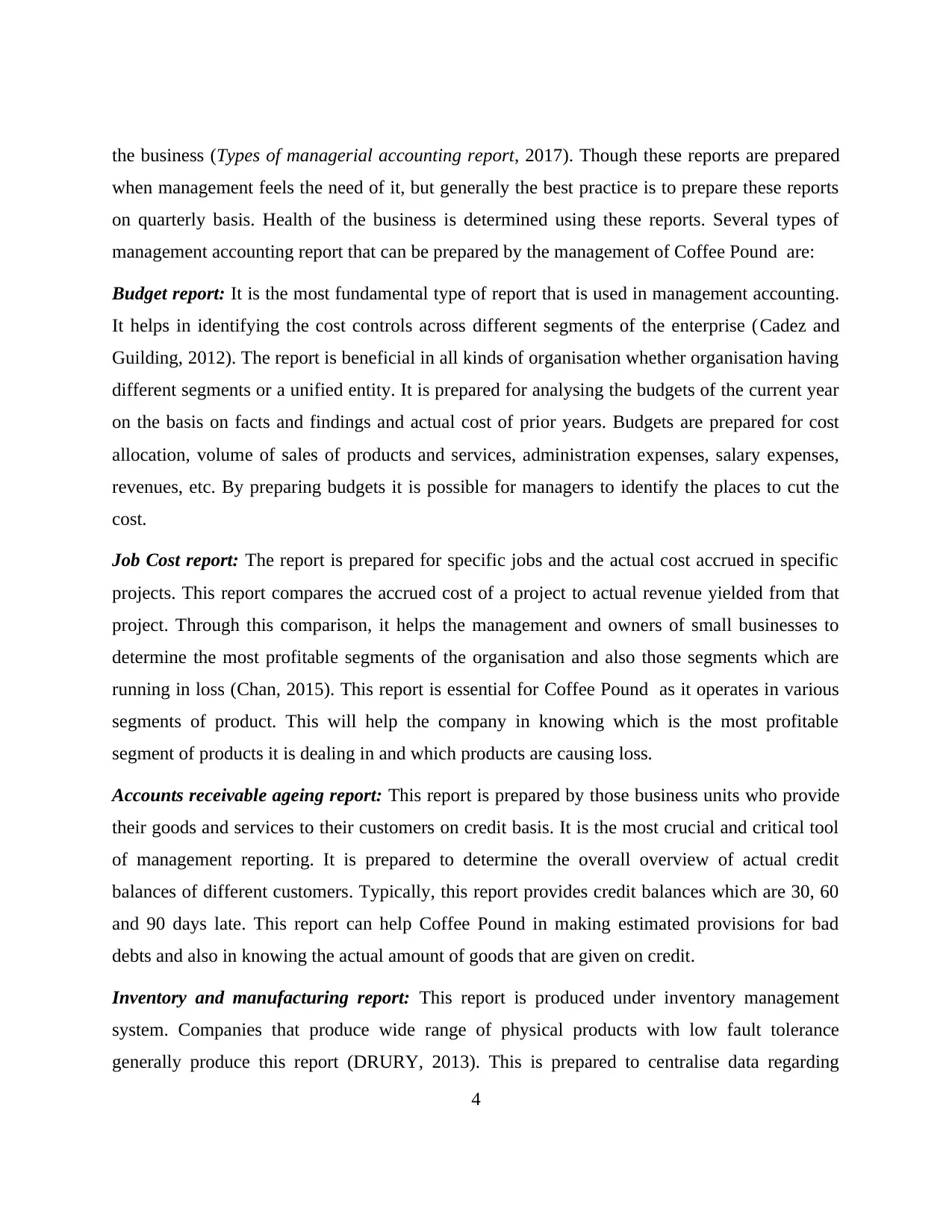
the business (Types of managerial accounting report, 2017). Though these reports are prepared
when management feels the need of it, but generally the best practice is to prepare these reports
on quarterly basis. Health of the business is determined using these reports. Several types of
management accounting report that can be prepared by the management of Coffee Pound are:
Budget report: It is the most fundamental type of report that is used in management accounting.
It helps in identifying the cost controls across different segments of the enterprise (Cadez and
Guilding, 2012). The report is beneficial in all kinds of organisation whether organisation having
different segments or a unified entity. It is prepared for analysing the budgets of the current year
on the basis on facts and findings and actual cost of prior years. Budgets are prepared for cost
allocation, volume of sales of products and services, administration expenses, salary expenses,
revenues, etc. By preparing budgets it is possible for managers to identify the places to cut the
cost.
Job Cost report: The report is prepared for specific jobs and the actual cost accrued in specific
projects. This report compares the accrued cost of a project to actual revenue yielded from that
project. Through this comparison, it helps the management and owners of small businesses to
determine the most profitable segments of the organisation and also those segments which are
running in loss (Chan, 2015). This report is essential for Coffee Pound as it operates in various
segments of product. This will help the company in knowing which is the most profitable
segment of products it is dealing in and which products are causing loss.
Accounts receivable ageing report: This report is prepared by those business units who provide
their goods and services to their customers on credit basis. It is the most crucial and critical tool
of management reporting. It is prepared to determine the overall overview of actual credit
balances of different customers. Typically, this report provides credit balances which are 30, 60
and 90 days late. This report can help Coffee Pound in making estimated provisions for bad
debts and also in knowing the actual amount of goods that are given on credit.
Inventory and manufacturing report: This report is produced under inventory management
system. Companies that produce wide range of physical products with low fault tolerance
generally produce this report (DRURY, 2013). This is prepared to centralise data regarding
4
when management feels the need of it, but generally the best practice is to prepare these reports
on quarterly basis. Health of the business is determined using these reports. Several types of
management accounting report that can be prepared by the management of Coffee Pound are:
Budget report: It is the most fundamental type of report that is used in management accounting.
It helps in identifying the cost controls across different segments of the enterprise (Cadez and
Guilding, 2012). The report is beneficial in all kinds of organisation whether organisation having
different segments or a unified entity. It is prepared for analysing the budgets of the current year
on the basis on facts and findings and actual cost of prior years. Budgets are prepared for cost
allocation, volume of sales of products and services, administration expenses, salary expenses,
revenues, etc. By preparing budgets it is possible for managers to identify the places to cut the
cost.
Job Cost report: The report is prepared for specific jobs and the actual cost accrued in specific
projects. This report compares the accrued cost of a project to actual revenue yielded from that
project. Through this comparison, it helps the management and owners of small businesses to
determine the most profitable segments of the organisation and also those segments which are
running in loss (Chan, 2015). This report is essential for Coffee Pound as it operates in various
segments of product. This will help the company in knowing which is the most profitable
segment of products it is dealing in and which products are causing loss.
Accounts receivable ageing report: This report is prepared by those business units who provide
their goods and services to their customers on credit basis. It is the most crucial and critical tool
of management reporting. It is prepared to determine the overall overview of actual credit
balances of different customers. Typically, this report provides credit balances which are 30, 60
and 90 days late. This report can help Coffee Pound in making estimated provisions for bad
debts and also in knowing the actual amount of goods that are given on credit.
Inventory and manufacturing report: This report is produced under inventory management
system. Companies that produce wide range of physical products with low fault tolerance
generally produce this report (DRURY, 2013). This is prepared to centralise data regarding
4
⊘ This is a preview!⊘
Do you want full access?
Subscribe today to unlock all pages.

Trusted by 1+ million students worldwide
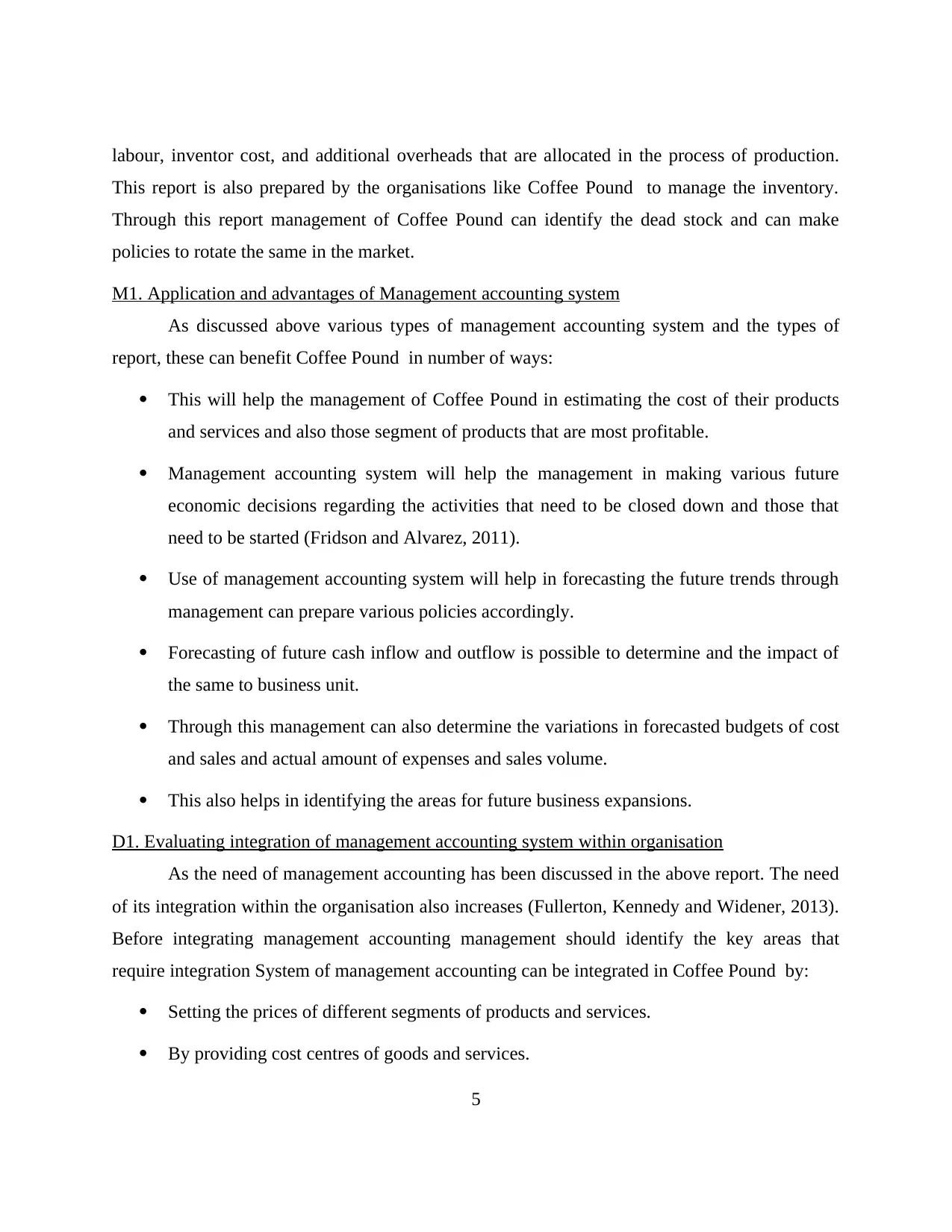
labour, inventor cost, and additional overheads that are allocated in the process of production.
This report is also prepared by the organisations like Coffee Pound to manage the inventory.
Through this report management of Coffee Pound can identify the dead stock and can make
policies to rotate the same in the market.
M1. Application and advantages of Management accounting system
As discussed above various types of management accounting system and the types of
report, these can benefit Coffee Pound in number of ways:
This will help the management of Coffee Pound in estimating the cost of their products
and services and also those segment of products that are most profitable.
Management accounting system will help the management in making various future
economic decisions regarding the activities that need to be closed down and those that
need to be started (Fridson and Alvarez, 2011).
Use of management accounting system will help in forecasting the future trends through
management can prepare various policies accordingly.
Forecasting of future cash inflow and outflow is possible to determine and the impact of
the same to business unit.
Through this management can also determine the variations in forecasted budgets of cost
and sales and actual amount of expenses and sales volume.
This also helps in identifying the areas for future business expansions.
D1. Evaluating integration of management accounting system within organisation
As the need of management accounting has been discussed in the above report. The need
of its integration within the organisation also increases (Fullerton, Kennedy and Widener, 2013).
Before integrating management accounting management should identify the key areas that
require integration System of management accounting can be integrated in Coffee Pound by:
Setting the prices of different segments of products and services.
By providing cost centres of goods and services.
5
This report is also prepared by the organisations like Coffee Pound to manage the inventory.
Through this report management of Coffee Pound can identify the dead stock and can make
policies to rotate the same in the market.
M1. Application and advantages of Management accounting system
As discussed above various types of management accounting system and the types of
report, these can benefit Coffee Pound in number of ways:
This will help the management of Coffee Pound in estimating the cost of their products
and services and also those segment of products that are most profitable.
Management accounting system will help the management in making various future
economic decisions regarding the activities that need to be closed down and those that
need to be started (Fridson and Alvarez, 2011).
Use of management accounting system will help in forecasting the future trends through
management can prepare various policies accordingly.
Forecasting of future cash inflow and outflow is possible to determine and the impact of
the same to business unit.
Through this management can also determine the variations in forecasted budgets of cost
and sales and actual amount of expenses and sales volume.
This also helps in identifying the areas for future business expansions.
D1. Evaluating integration of management accounting system within organisation
As the need of management accounting has been discussed in the above report. The need
of its integration within the organisation also increases (Fullerton, Kennedy and Widener, 2013).
Before integrating management accounting management should identify the key areas that
require integration System of management accounting can be integrated in Coffee Pound by:
Setting the prices of different segments of products and services.
By providing cost centres of goods and services.
5
Paraphrase This Document
Need a fresh take? Get an instant paraphrase of this document with our AI Paraphraser
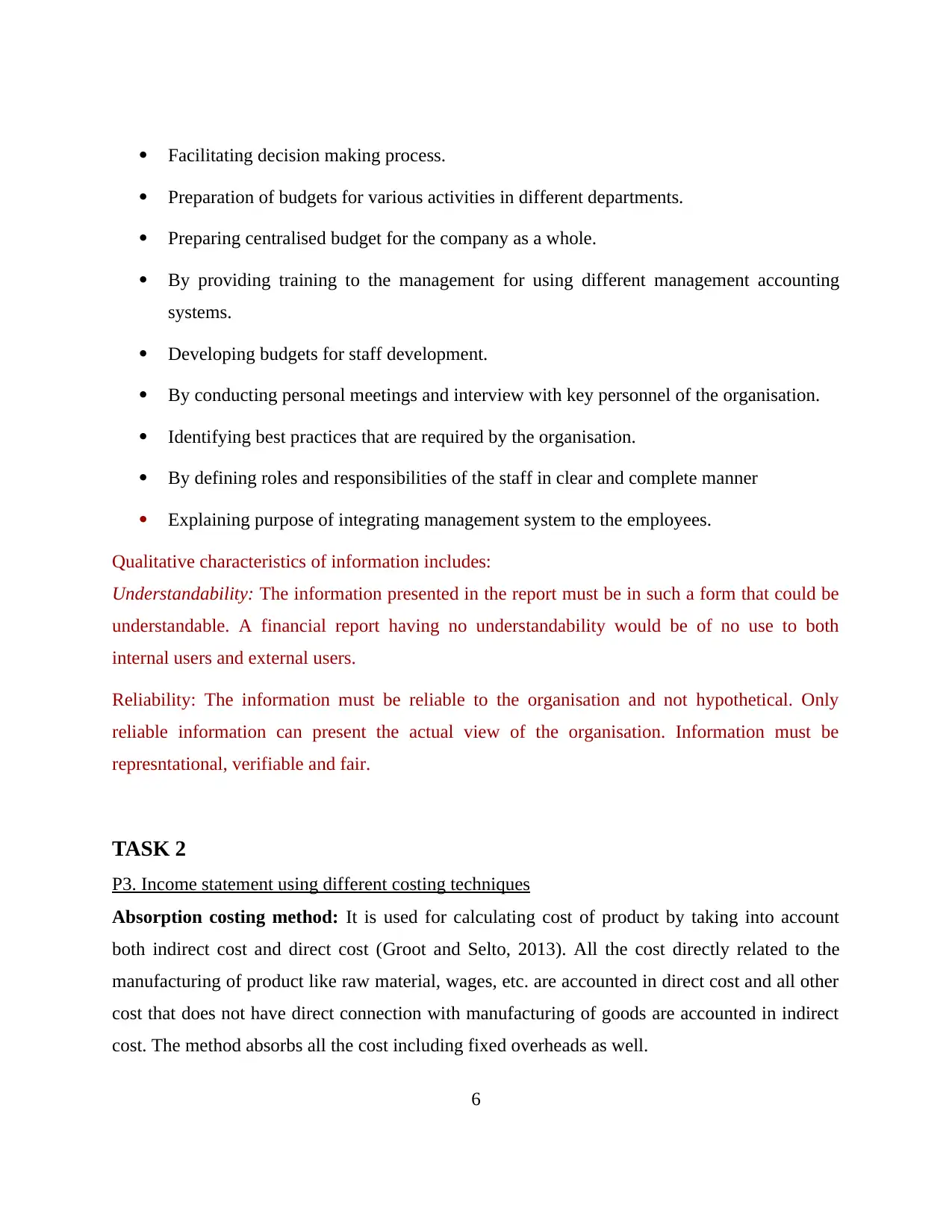
Facilitating decision making process.
Preparation of budgets for various activities in different departments.
Preparing centralised budget for the company as a whole.
By providing training to the management for using different management accounting
systems.
Developing budgets for staff development.
By conducting personal meetings and interview with key personnel of the organisation.
Identifying best practices that are required by the organisation.
By defining roles and responsibilities of the staff in clear and complete manner
Explaining purpose of integrating management system to the employees.
Qualitative characteristics of information includes:
Understandability: The information presented in the report must be in such a form that could be
understandable. A financial report having no understandability would be of no use to both
internal users and external users.
Reliability: The information must be reliable to the organisation and not hypothetical. Only
reliable information can present the actual view of the organisation. Information must be
represntational, verifiable and fair.
TASK 2
P3. Income statement using different costing techniques
Absorption costing method: It is used for calculating cost of product by taking into account
both indirect cost and direct cost (Groot and Selto, 2013). All the cost directly related to the
manufacturing of product like raw material, wages, etc. are accounted in direct cost and all other
cost that does not have direct connection with manufacturing of goods are accounted in indirect
cost. The method absorbs all the cost including fixed overheads as well.
6
Preparation of budgets for various activities in different departments.
Preparing centralised budget for the company as a whole.
By providing training to the management for using different management accounting
systems.
Developing budgets for staff development.
By conducting personal meetings and interview with key personnel of the organisation.
Identifying best practices that are required by the organisation.
By defining roles and responsibilities of the staff in clear and complete manner
Explaining purpose of integrating management system to the employees.
Qualitative characteristics of information includes:
Understandability: The information presented in the report must be in such a form that could be
understandable. A financial report having no understandability would be of no use to both
internal users and external users.
Reliability: The information must be reliable to the organisation and not hypothetical. Only
reliable information can present the actual view of the organisation. Information must be
represntational, verifiable and fair.
TASK 2
P3. Income statement using different costing techniques
Absorption costing method: It is used for calculating cost of product by taking into account
both indirect cost and direct cost (Groot and Selto, 2013). All the cost directly related to the
manufacturing of product like raw material, wages, etc. are accounted in direct cost and all other
cost that does not have direct connection with manufacturing of goods are accounted in indirect
cost. The method absorbs all the cost including fixed overheads as well.
6
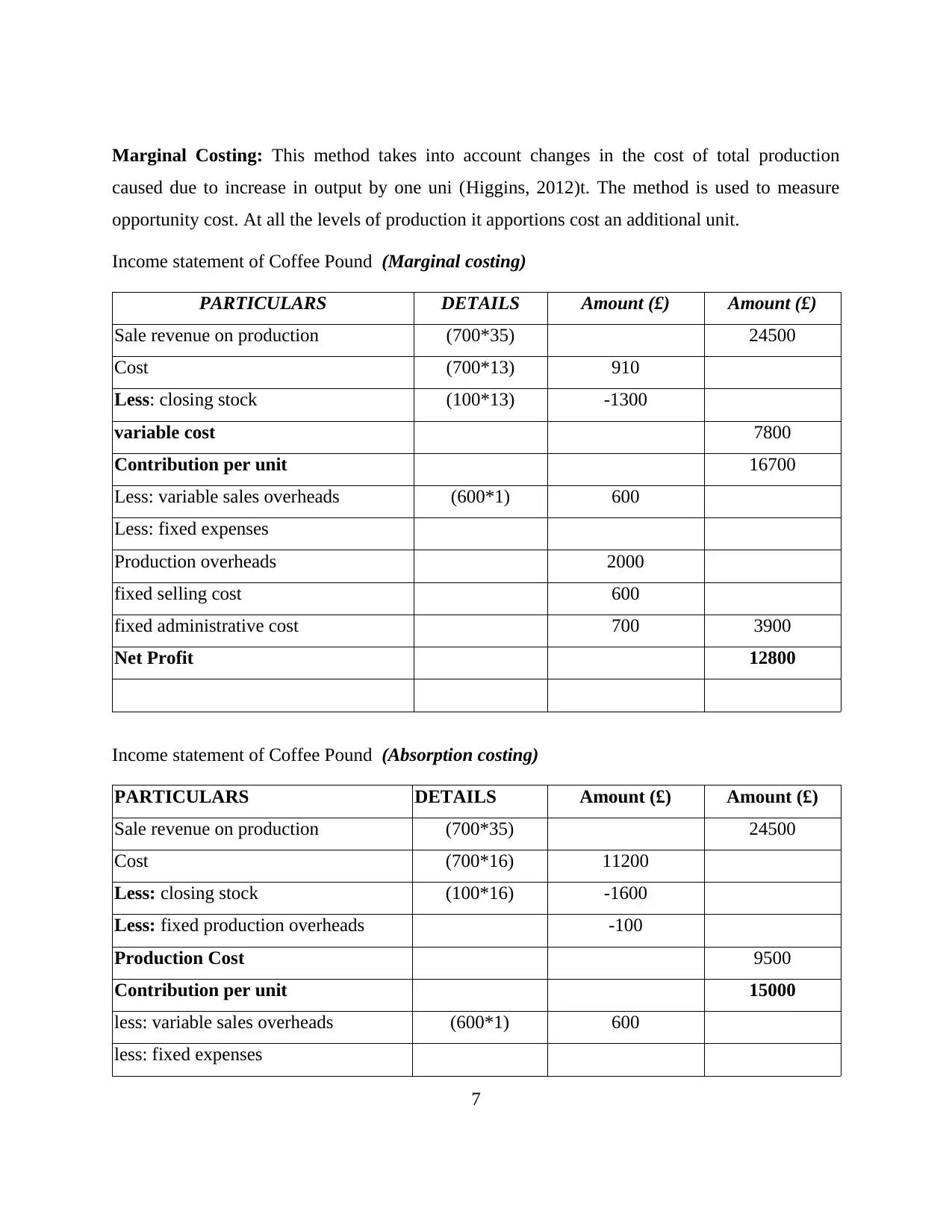
Marginal Costing: This method takes into account changes in the cost of total production
caused due to increase in output by one uni (Higgins, 2012)t. The method is used to measure
opportunity cost. At all the levels of production it apportions cost an additional unit.
Income statement of Coffee Pound (Marginal costing)
PARTICULARS DETAILS Amount (£) Amount (£)
Sale revenue on production (700*35) 24500
Cost (700*13) 910
Less: closing stock (100*13) -1300
variable cost 7800
Contribution per unit 16700
Less: variable sales overheads (600*1) 600
Less: fixed expenses
Production overheads 2000
fixed selling cost 600
fixed administrative cost 700 3900
Net Profit 12800
Income statement of Coffee Pound (Absorption costing)
PARTICULARS DETAILS Amount (£) Amount (£)
Sale revenue on production (700*35) 24500
Cost (700*16) 11200
Less: closing stock (100*16) -1600
Less: fixed production overheads -100
Production Cost 9500
Contribution per unit 15000
less: variable sales overheads (600*1) 600
less: fixed expenses
7
caused due to increase in output by one uni (Higgins, 2012)t. The method is used to measure
opportunity cost. At all the levels of production it apportions cost an additional unit.
Income statement of Coffee Pound (Marginal costing)
PARTICULARS DETAILS Amount (£) Amount (£)
Sale revenue on production (700*35) 24500
Cost (700*13) 910
Less: closing stock (100*13) -1300
variable cost 7800
Contribution per unit 16700
Less: variable sales overheads (600*1) 600
Less: fixed expenses
Production overheads 2000
fixed selling cost 600
fixed administrative cost 700 3900
Net Profit 12800
Income statement of Coffee Pound (Absorption costing)
PARTICULARS DETAILS Amount (£) Amount (£)
Sale revenue on production (700*35) 24500
Cost (700*16) 11200
Less: closing stock (100*16) -1600
Less: fixed production overheads -100
Production Cost 9500
Contribution per unit 15000
less: variable sales overheads (600*1) 600
less: fixed expenses
7
⊘ This is a preview!⊘
Do you want full access?
Subscribe today to unlock all pages.

Trusted by 1+ million students worldwide
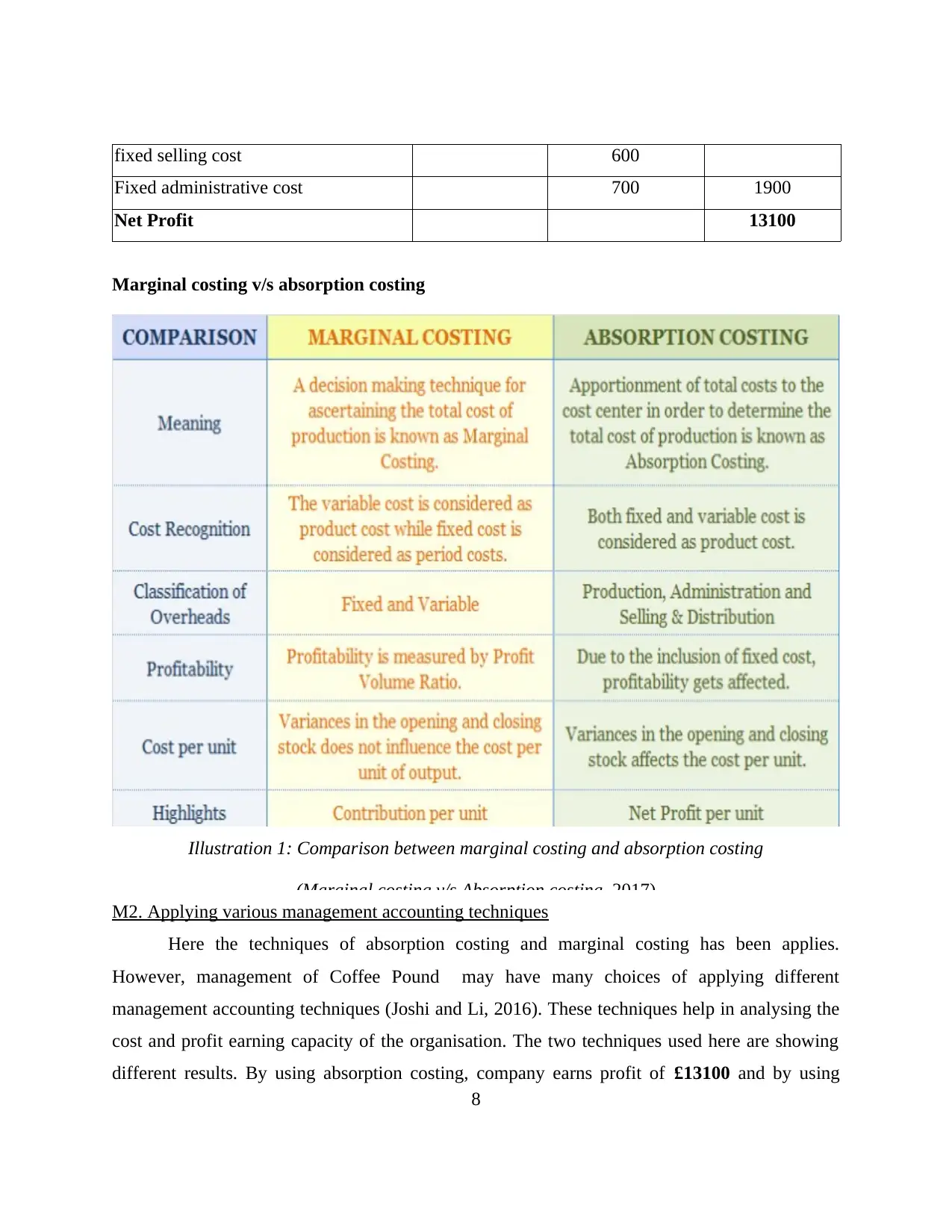
fixed selling cost 600
Fixed administrative cost 700 1900
Net Profit 13100
Marginal costing v/s absorption costing
Illustration 1: Comparison between marginal costing and absorption costing
(Marginal costing v/s Absorption costing, 2017)
M2. Applying various management accounting techniques
Here the techniques of absorption costing and marginal costing has been applies.
However, management of Coffee Pound may have many choices of applying different
management accounting techniques (Joshi and Li, 2016). These techniques help in analysing the
cost and profit earning capacity of the organisation. The two techniques used here are showing
different results. By using absorption costing, company earns profit of £13100 and by using
8
Fixed administrative cost 700 1900
Net Profit 13100
Marginal costing v/s absorption costing
Illustration 1: Comparison between marginal costing and absorption costing
(Marginal costing v/s Absorption costing, 2017)
M2. Applying various management accounting techniques
Here the techniques of absorption costing and marginal costing has been applies.
However, management of Coffee Pound may have many choices of applying different
management accounting techniques (Joshi and Li, 2016). These techniques help in analysing the
cost and profit earning capacity of the organisation. The two techniques used here are showing
different results. By using absorption costing, company earns profit of £13100 and by using
8
Paraphrase This Document
Need a fresh take? Get an instant paraphrase of this document with our AI Paraphraser
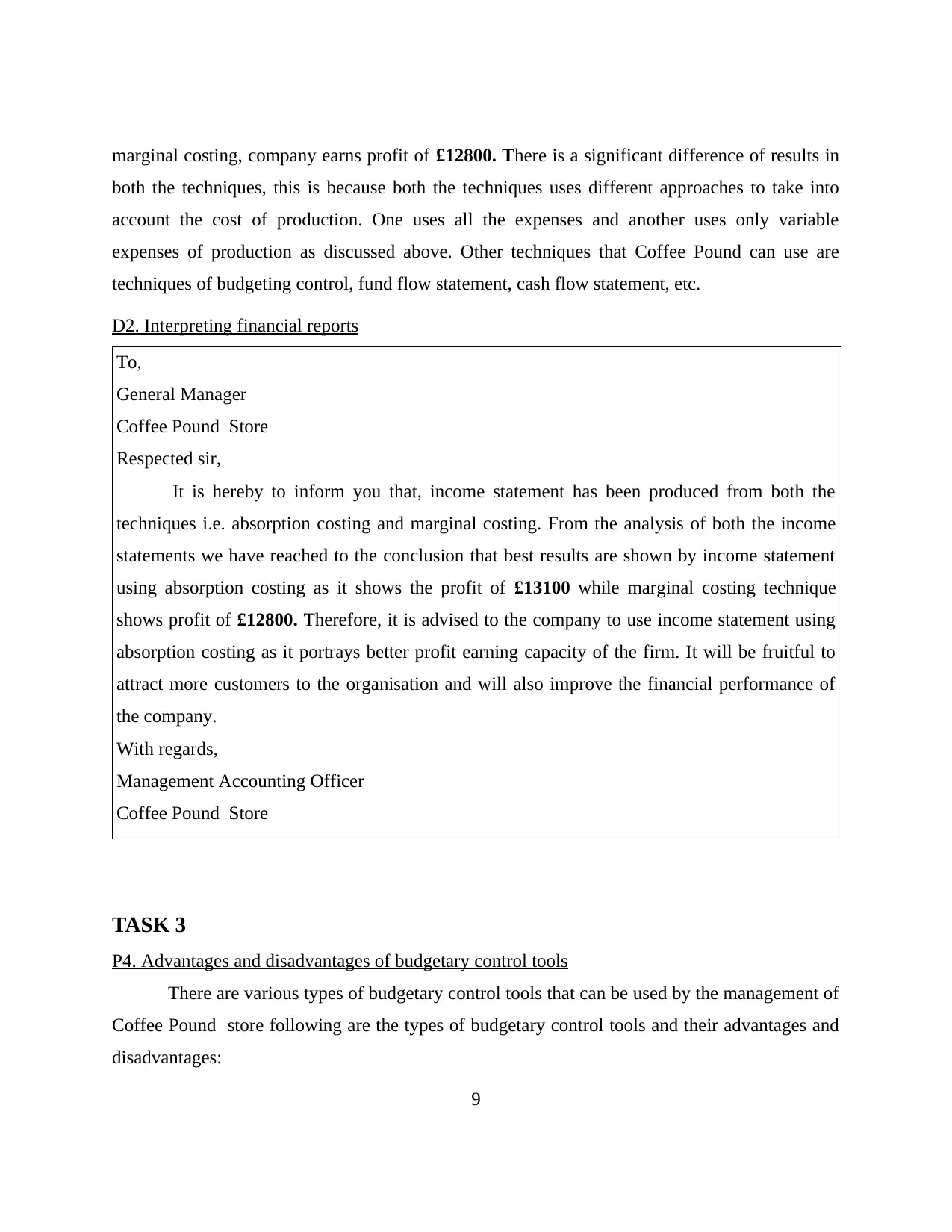
marginal costing, company earns profit of £12800. There is a significant difference of results in
both the techniques, this is because both the techniques uses different approaches to take into
account the cost of production. One uses all the expenses and another uses only variable
expenses of production as discussed above. Other techniques that Coffee Pound can use are
techniques of budgeting control, fund flow statement, cash flow statement, etc.
D2. Interpreting financial reports
To,
General Manager
Coffee Pound Store
Respected sir,
It is hereby to inform you that, income statement has been produced from both the
techniques i.e. absorption costing and marginal costing. From the analysis of both the income
statements we have reached to the conclusion that best results are shown by income statement
using absorption costing as it shows the profit of £13100 while marginal costing technique
shows profit of £12800. Therefore, it is advised to the company to use income statement using
absorption costing as it portrays better profit earning capacity of the firm. It will be fruitful to
attract more customers to the organisation and will also improve the financial performance of
the company.
With regards,
Management Accounting Officer
Coffee Pound Store
TASK 3
P4. Advantages and disadvantages of budgetary control tools
There are various types of budgetary control tools that can be used by the management of
Coffee Pound store following are the types of budgetary control tools and their advantages and
disadvantages:
9
both the techniques, this is because both the techniques uses different approaches to take into
account the cost of production. One uses all the expenses and another uses only variable
expenses of production as discussed above. Other techniques that Coffee Pound can use are
techniques of budgeting control, fund flow statement, cash flow statement, etc.
D2. Interpreting financial reports
To,
General Manager
Coffee Pound Store
Respected sir,
It is hereby to inform you that, income statement has been produced from both the
techniques i.e. absorption costing and marginal costing. From the analysis of both the income
statements we have reached to the conclusion that best results are shown by income statement
using absorption costing as it shows the profit of £13100 while marginal costing technique
shows profit of £12800. Therefore, it is advised to the company to use income statement using
absorption costing as it portrays better profit earning capacity of the firm. It will be fruitful to
attract more customers to the organisation and will also improve the financial performance of
the company.
With regards,
Management Accounting Officer
Coffee Pound Store
TASK 3
P4. Advantages and disadvantages of budgetary control tools
There are various types of budgetary control tools that can be used by the management of
Coffee Pound store following are the types of budgetary control tools and their advantages and
disadvantages:
9
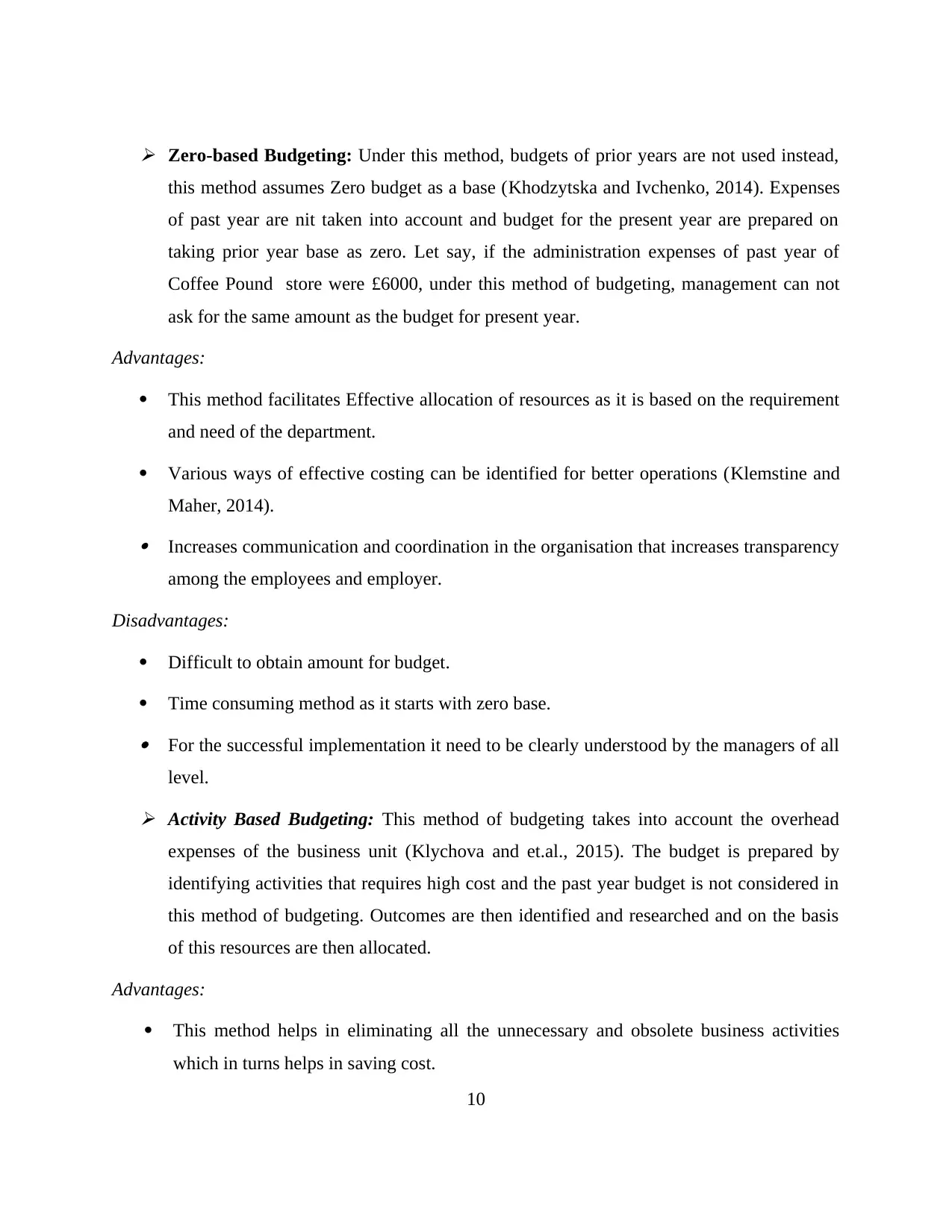
Zero-based Budgeting: Under this method, budgets of prior years are not used instead,
this method assumes Zero budget as a base (Khodzytska and Ivchenko, 2014). Expenses
of past year are nit taken into account and budget for the present year are prepared on
taking prior year base as zero. Let say, if the administration expenses of past year of
Coffee Pound store were £6000, under this method of budgeting, management can not
ask for the same amount as the budget for present year.
Advantages:
This method facilitates Effective allocation of resources as it is based on the requirement
and need of the department.
Various ways of effective costing can be identified for better operations (Klemstine and
Maher, 2014). Increases communication and coordination in the organisation that increases transparency
among the employees and employer.
Disadvantages:
Difficult to obtain amount for budget.
Time consuming method as it starts with zero base. For the successful implementation it need to be clearly understood by the managers of all
level. Activity Based Budgeting: This method of budgeting takes into account the overhead
expenses of the business unit (Klychova and et.al., 2015). The budget is prepared by
identifying activities that requires high cost and the past year budget is not considered in
this method of budgeting. Outcomes are then identified and researched and on the basis
of this resources are then allocated.
Advantages:
This method helps in eliminating all the unnecessary and obsolete business activities
which in turns helps in saving cost.
10
this method assumes Zero budget as a base (Khodzytska and Ivchenko, 2014). Expenses
of past year are nit taken into account and budget for the present year are prepared on
taking prior year base as zero. Let say, if the administration expenses of past year of
Coffee Pound store were £6000, under this method of budgeting, management can not
ask for the same amount as the budget for present year.
Advantages:
This method facilitates Effective allocation of resources as it is based on the requirement
and need of the department.
Various ways of effective costing can be identified for better operations (Klemstine and
Maher, 2014). Increases communication and coordination in the organisation that increases transparency
among the employees and employer.
Disadvantages:
Difficult to obtain amount for budget.
Time consuming method as it starts with zero base. For the successful implementation it need to be clearly understood by the managers of all
level. Activity Based Budgeting: This method of budgeting takes into account the overhead
expenses of the business unit (Klychova and et.al., 2015). The budget is prepared by
identifying activities that requires high cost and the past year budget is not considered in
this method of budgeting. Outcomes are then identified and researched and on the basis
of this resources are then allocated.
Advantages:
This method helps in eliminating all the unnecessary and obsolete business activities
which in turns helps in saving cost.
10
⊘ This is a preview!⊘
Do you want full access?
Subscribe today to unlock all pages.

Trusted by 1+ million students worldwide
1 out of 19
Related Documents
Your All-in-One AI-Powered Toolkit for Academic Success.
+13062052269
info@desklib.com
Available 24*7 on WhatsApp / Email
![[object Object]](/_next/static/media/star-bottom.7253800d.svg)
Unlock your academic potential
Copyright © 2020–2025 A2Z Services. All Rights Reserved. Developed and managed by ZUCOL.





